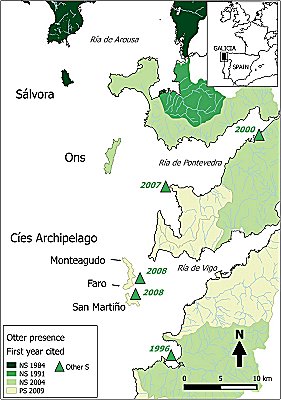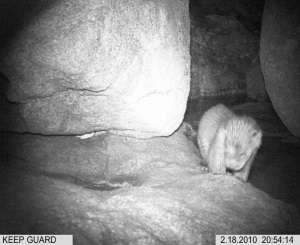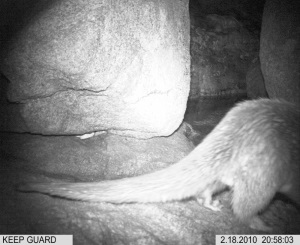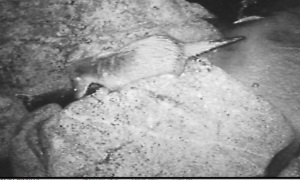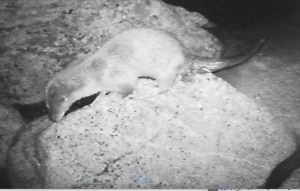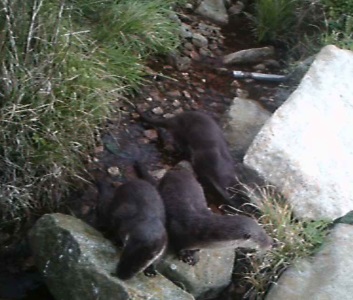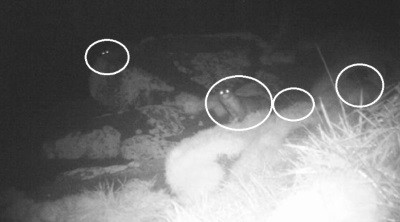IUCN/SSC Otter Specialist Group Bulletin

©IUCN/SCC Otter Specialist Group
Volume 35 Issue 1 (January 2018)
Citation: Romero Suances, R (2018). The Recovery of a Coastal Eurasian Otter (Lutra lutra) Population in the Galician Atlantic Islands Maritime-Terrestrial National Park. IUCN Otter Spec. Group Bull. 35 (1): 37 - 46
The Recovery of a Coastal Eurasian Otter (Lutra lutra) Population in the Galician Atlantic Islands Maritime-Terrestrial National Park
Rafael Romero Suances1*
1 Presidente Salvador Allende n° 3, baixo A - 15705 Santiago de Compostela, Spain e-mail: rromerosuances@gmail.com
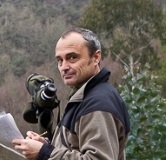 |
| (Received 10th July 2017, accepted 5th November 2017) |
| Download PDF (1.10 MB) |
| Abstract: In Galicia (NW of the Iberian Peninsula) there is an important population of coastal Eurasian otters (Lutra lutra), some of which are present on islands. This study analyses the recent historical evolution of the species distribution along the Galician Atlantic Islands Maritime-Terrestrial National Park. National surveys of years 1984, 1994 and 2005, other local surveys conducted between 2000 and 2017, some publications and other technical reports have been used for this purpose. Also, between 2010 and 2017, the number of otters inhabiting each island and their relative age were estimated using camera traps. According to the information collected, otters may have disappeared or become very scarce in the last third of the 20th century. However, from the beginning of the 21st century, their populations began to recover, occupying today all the islands and the closest coasts. It has been confirmed otter breeding in all islands between 2010 and 2017. The average size of the observed litters was 1.89 cubs. There does not seem to be a well-defined breeding season pattern. For each of the islands, a minimum population of 4 otters was recorded. |
| Keywords: Lutra lutra, island population, distribution, breeding, Galicia, NW Iberian Peninsula |
| Française | Español |
INTRODUCTION
The Eurasian otter (Lutra lutra L.) occupies some coastal areas of northern and western Europe, mainly in Great Britain, Norway, France, Portugal and Spain (Macdonald and Mason 1994; Trindade et al., 1998; Romero, 2008). In these coastal areas, it is also present in islands, as is the case with some archipelagos of Scotland (Kruuk, 2006), Norway (Heggberget and Christensen, 1994), French Brittany (Lafontaine, 2001) and Denmark (Elmeros et al., 2006). In the Iberian Peninsula, the only population of otters living on islands is probably the one find in Galicia (NW Spain) (Ruiz-Olmo and Delibes, 1998). On its coasts, there are a large number of islets and islands, many of which are inhabited or visited sporadically by otters (Romero et al., 2008).
The small islands or archipelago of Sálvora, Ons and Cíes are among the largest in Galicia, and are now included in the Galician Atlantic Islands Maritime-Terrestrial National Park. They are located within the coastal areas with the highest human density in Galicia, currently experiencing an industrial growth. Otter populations in this coastal area declined or even disappeared by the end of the 20th century. This study describes the recent recovery of otter populations in these islands and closest coasts from data obtained from various surveys and bibliographical references. In addition, information about the breeding of the species is provided based on data collected by using remote cameras.
METHODS
Study area
The study area includes three small archipelagos located at the entrance of Rías (sea inlets) Baixas (coastal region of the SW of Galicia, NW Spain), belonging to the Galician Atlantic Islands Maritime-Terrestrial National Park (PNMTIAG) (Figure 1). From north to south the archipelagos included are Sálvora, Ons and Cíes (this last includes the islands of Monteagudo, Faro and San Martiño), located respectively at the entrance of the Rías of Arousa, Pontevedra and Vigo. Each of them is formed by one or three main islands and numerous islets. The length of the main islands varies between 2.5 km and 5 km, and its surface area between 152 ha and 416 ha. The information used here refers exclusively to the main islands of each archipelago (Figure 1).
Review of information
The main source of information to analyse the evolution of otter occurrence in the islands and closest coasts was the national surveys conducted in 1984 (Delibes, 1990), 1992 (Munilla et al., 1998) and 2004 (Romero, 2008). In addition, data collected between 2000 and 2017 (direct observations of otters and dead specimens), as well as information from local surveys (own data) conducted in the islands also between 2000 and 2017, were used. For the 20th century, data from books on biology and ecology of local natural spaces, technical reports, and even literature books, were also taken into account (Table 1).
| Table 1: Information on the presence of otter in the islands from 1984 (0, No signs of otter during survey; 1, Indirect reference; 2, footprints; 3, spraints; 4, unspecified data; Sings (spraints or footprints) are highlighted in gray. The numbers in parentheses indicate the following bibliographical references (A), Delibes (1990), (B) Callejo (1986), (C), Fernández de la Cigoña (1991), (D), Munilla et al., (1998), (E) Chouza and Cid (1995), (F) Tragsatec (1999), (G) Romero (2006), (H) Romero (2008), (I to T) Romero (Own data). Highlight in green data from footprints or spraints. Click for larger version |
 |
|
|
Camera traps
Camera trapping were carried out between 2010 and 2017. Two models of cameras were used: Scoutguard SG550 and Moultrie M-990i. In Ons island a short photo-trapping campaigns were carried out using one or two cameras, only in 2011 and 2012. In the other islands, camera trapping has been more continuous over the years, although the effort (no. cameras/day) was very uneven (Table 2). Each photograph or video, called event, was individualized according to date and location. An independent event was considered as a set of photographs or videos made at intervals of more than 60 minutes (Wagnon and Serfass, 2016). Four age classes were defined, depending on the relative size of the individuals observed together in the same scene or event (photograph or video). The sizes or classes considered were based, with some modifications, on the definitions used by Ruiz-Olmo et al. (2002):
- Very small cubs. Individuals equal to or less than 1/2 adult length. It includes cubs of approximately 2-3 months (Figure 2).
- Small cubs. Individuals smaller than an adult, but larger than 1/2 adult lenght. It includes cubs from more than 2-3 months to 6 months old (Figure 3).
- Large cubs. Similar size and difficulty to distinguish from an adult. More than six months. Within this category, were classified those otters observed in group (two or more individuals) that exhibited markedly restless behaviour, with frequent games, and apparent dependence or attention on another individual (assumed as an adult/mother) (Figure 4).
- Adult or probably adult. Large size. Within this category are otters of comparatively larger size, and those apparently large when detected alone in an event.
The size of the litters detected in the different events was estimated excluding individuals who clearly had a larger size (adults) or attending to their behaviour as explained above.
RESULTS AND DISCUSSION
Presence and recovery of the otter along the Galician coast
The information collected suggests that the otter must have been present historically on coasts and islands of the Rías Baixas. There are place names (toponyms) that refer to the existence of otters in the islands of Monteagudo (“Furna das lontras”: means “cave of otters”) and in Sálvora (“As Lontreiras”: means “place frequented by otters”). Toponyms very similar to these can also be found at various points along the continental coast of the Rías Baixas (Romero 2006). Although no data are available, it is likely that the presence of otters on the coast and islands has been constant until the last third of the 20th century. Until the mid-twentieth century otters were hunted on the continental coast, and systematically captured on the island of Ons to sell its skin. Until the 1960s, there were still otters in some small coastal basins of the Vigo and Pontevedra Rías (Blas-Aritio, 1970).
However, during the first field surveys conducted in 1984 (Delibes, 1990), the presence of otters could be confirmed only in some of the northern coastal basins of the study area (Figure 1). According to the following field surveys performed in 1991 (Munilla et al., 1998) and 2004 (Romero, 2008), otter signs of presence (spraints, foot-prints) were detected in the southernmost coastal basins. The occurrence of dead otters and the detection of signs of presence between 2006 and 2009 (Own data) confirmed the presence of the species throughout this coastal zone during these years (Figure 1). Probably, the species was progressively scarce from the 1960s until disappearing, or at least becoming very scarce, in the 80s. From then on, their populations would recover, until they occupied the entire area of present study.Presence and recolonization of the PNMTIAG islands
There are references to the presence of otters in the PNMTIAG islands during much of the study period (Table 1). Some publications and technical reports mention the existence of otters in the southern islands (Ons and Cíes) during the 1980s and 1990s (Table 1). Some of these references, however, are somewhat ambiguous, since they refer to data from third parties without specifying a particular date, whether it was a sighting or a footprint or a spraint. However, field surveys conducted between 1999 and 2002, despite being very intensive, did not detect the presence of the species in these islands. This suggests that during the first half of the study period (1984-2006), although the otter could be occasionally present in the southernmost islands (Cíes), it probably did not have a settled population and their presence must have been sporadic. In light of the results of the otter surveys carried out, the real recolonization of the islands occurred in 2008 (Figure 1).
The presence of the otter in the islands seems to be a consequence of their occurrence on the nearest coast. On the northernmost island (Sálvora), its presence was detected throughout the study period, as in the closest coastal basins (Table 1 and Figure 1). The same is true of the rest of the islands, where the appearance of the otter is practically simultaneous with its appearance on the nearest coasts (Figure 1).
The colonization of the islands is more likely to be done from the nearest coasts, distant between 3.7 km and 2.5 km in a straight line, than from Sálvora, which is between 9.5 km and over 20 km. Although records of displacement of otters on the coast of more than 30 km have been referred, the most common movements are of a few kilometres between some coastal locations or very close islands (Kruuk and Moorhouse, 1991).
The recolonization of the SW coast of Galicia and the nearby Atlantic islands could be framed within the general context of recovery of the Iberian otter populations, as in most of Europe during recent decades (Prigioni et al., 2007; Weinberger et al., 2016). In Galicia the causes of such recovery are not known. Apart from the possible effects of pollution on the decline of their populations (Macdonald and Mason, 1994), hunting and direct persecution may have had some influence, as in the recent past in certain areas of Great Britain and Spain (Strachan and Jefferies, 1996; Delibes, 1990). It is noteworthy that in Spain in 1963, otter hunting was prohibited by law, which could have had a direct effect on the later recovery of otter populations in the Rías Baixas region.
Otter breeding in the islands (2010 to 2017)
During the study period it was possible to confirm otter reproduction in all the islands of the PNMTIAG (Table 2). Small-sized offspring were only found in 2010 on the northernmost island (Sálvora) and in 2011 on the central island (Ons) (Figure 2). In the events recorded later, several groups with otters of different size and behaviour (small or large cubs) were observed (Figures 3, 4 and 5). Data collected during the study period suggest that the species breed almost uninterrupted between 2010 and 2017 on the island of Sálvora (Table 2). It also probably breeds in Faro and Monteagudo islands, since footprints of three specimens walking together were detected between 2014 and 2016.
Of a total of 217 events in which otters were detected, 83.4% corresponded to single individuals classified almost all of them as adults, while the remaining 16.6% corresponded to groups of 2 to 4 individuals. The group that accumulated a greater number of events was formed by 3 otters (Figure 4), followed by the groups formed by 2 and 4 otters respectively (Figure 5). By counting only the events with several individuals (n = 35), the mean size of these groups was 2.6 individuals (± 0.608 sd.; n = 35). The mean litter size was estimated at 1.77 individuals (± 0.426 sd.; n = 35). It should be noted, however, that most of the events recorded may correspond to the same litters observed repeatedly. Assuming that all the events of each year belong to the same litter, and counting only the maximum number of cubs detected in each of them, the average litter size for the total of the islands would be 1.89 ± 0.33 (sd., n = 9) (Table 3).
In other coastal localities of Europe the sizes of otter litters are very similar to those estimated here. In Portugal, Beja (1996) obtained an average of 1.73 cubs for a total of 11 litters. On the coasts of Norway, Heggberget and Christensen (1994) find an average of 2.0 cubs, while in Shetland the average is 1.86 cubs for 102 litters (Kruuk et al., 1991).
Individuals belonging to the very small cubs class (<1/2 of adult size) were detected in February (Sálvora Island) and March (Island of Ons). Assuming an age of between 2 and 3 months, it means that they could be born between November and January. Individuals belonging to the other two size classes considered (small cubs and large cubs) could be observed throughout the year (Table 4). For this reason, although these data may be compatible with births during the winter or spring, nor it could be confirmed. It is possible that the otter does not have a specific breeding period in the islands, as in other coastal areas of Europe (Heggberget and Christensen, 1994; Beja, 1996; Kruuk, 2006). Although it would be necessary more detailed information in order to confirm this.
It was possible to confirm the simultaneous existence of an isolated individual and a family group in the islands of Monteagudo, Faro and Sálvora. In addition, a group of 4 otters were located on the island of San Martiño. In the absence of more information, this number of individuals (n = 4) could constitute the minimum size of the otter population in each of the 5 main islands of PNMTIAG. However the Cíes Islands are very close to each other, so the same group of otters could occupy more than one island.
CONSERVATION
The existence of otter groups in all the islands included in PNMTIAG increases the value of this natural space. Therefore, its conservation should be a primary objective in the management of the National Park. However, the islands that comprise it are located on coasts with a dense and growing human population, which could hamper the future of their otter populations. The entire coastal area of the Rías Baixas supports growing industrialization and a considerable increase in tourism. Due to the small size of island otter populations, they are likely to depend on the nearest continental populations to survive. For this reason, the management measures applied to the species should include the entire coast of the Rías Baixas. It is paradoxical that the coastal otter populations of a national park such as PNMTIAG depend on the otter populations living on the most heavily populated and probably more degraded coasts of Galicia.
Acknowledgements: I am very grateful to the staff of the Atlantic Islands of Galicia National Park who help me to do this study, and also to the lighthouse keepers of the Isle of Sálvora for the logistic support during all of the study period. I also thank J.A. Fernández, director of the National Park, and V. Piorno, for encouraging this study and for his general support. Also thanks to C. Docampo for his help during the fieldwork and image processing and for reading several drafts of this manuscript, and to Laurent Cortijos for the translation of the abstract into French.
REFERENCES
Beja, P. R. (1996). Seasonal breeding and food resources of otters, Lutra lutra (Carnivora, Mustelidae), in south-west Portugal: a comparison between coastal and inland habitats. Mammalia 60 (1): 27-34.
Blas-Aritio, L. (1970). Vida y costumbres de los mustélidos españoles. Servicio de Pesca Continental, Caza y Parques Nacionales. Madrid ([in Spanish].
Callejo, A. (1986). Contribución al conocimiento faunístico de las islas Cíes y Ons. Delegación Provincial de Pontevedra de la Consellería de Agricultura, Gandería y Montes. Xunta de Galicia. 48 pp. Unpublished report [in Spanish].
Chouza, M., Cid, R. (1995). Mamíferos. En: Atlas de Vertebrados de Galicia. Tomo I. Peixes, Anfibios, Reptiles e Mamíferos. Sociedade Galega de Historia Natural, Consello da Cultura Galega. Santiago de Compostela [in Galician].
Delibes, M. (1990). La nutria (Lutra lutra) en España. ICONA Serie Técnica, Madrid.
Elmeros, M., Hammershoj, M., Madsen, A., Sogaard, B. (2006). Recovery of the otter Lutra lutra in Denmark monitored by field surveys and collection of carcasses. Hystrix It. J. Mamm., 17(1):17-28.
Fernández de la Cigoña, E. (1991). Illas de Galicia: Cíes, Ons, Sálvora, Tambo, San Simón e Cortegada. Ed. Xerais de Galicia, Vigo. [in Galician].
Heggberget, T. M., Christensen, H. (1994). Reproductive timing in Eurasian otters on the coast of Norway. Ecography 17 (4): 339-348.
Kruuk, H. (2006). Otters: ecology, behaviour and conservation. Oxford University Press.
Kruuk, H., Moorhouse, A. (1991). The spatial organization of otters (Lutra lutra) in Shetland. J. Zool. 224 (1): 41-57.
Kruuk, H., Conroy, J. W. H., Moorhouse, A. (1991). Recruitment to a population of otters (Lutra lutra) in Shetland, in relation to fish abundance. J. Appl. Ecol. 28 (1): 95-101.
Lafontaine, L. (2001). La loutre d’Europe (Lutra lutra) sur le littoral et les îles de Bretagne. URL.http://etudes.bretagne-environnement.org/index.php?lvl=notice_display&id=17264
Macdonald, S.M., Mason, C.F. (1994). Status and conservation needs of the otter (Lutra lutra) in the western Paleartic. Council of Europe Press. Nature and environment, no 67.
Munilla, I., Romero, R., Callejo, A. (1998). Galicia. In: Ruiz-Olmo, J. & Delibes, M. (Eds.) (1998). La nutria en España ante el horizonte del año 2000. SECEM. Barcelona, Sevilla, Malaga, pp. 157-164. [In Spanish with English abstract].
Prigioni, C., Balestrieri, A., Remonti, L. (2007). Decline and recovery in otter Lutra lutra populations in Italy. Mammal Rev. 37(1): 71-79.
Romero, R. (2006). La nutria (Lutra lutra L.) en Galicia: Distribución geográfica y ecología trófica de las poblaciones costeras. Tesis doctoral. Universidade de Santiago de Compostela. 215 pp [In Spanish with English abstract].
Romero, R. (2008). La Nutria en Galicia. In: López-Martín, J. M. & J. Jiménez (Eds.) (2008). La nutria en España. Veinte años de seguimiento de un mamífero amenazado. SECEM, Málaga, pp 143-156. [In Spanish with English abstract].
Romero, R., Nores, C., García-Rovés, P, Guitián, J., Ruiz-Olmo, J. (2008). Distribución y uso del espacio costero de las nutrias en la fachada cántabro-atlántica. In: J. M. López-Martín & J. Jiménez (Eds.). La nutria en España. Veinte años de seguimiento de un mamífero amenazado. SECEM, Málaga, pp: 397-420 [In Spanish with English abstract].
Ruiz-Olmo, J. & Delibes, M. (Eds.) (1998). La nutria en España ante el horizonte del año 2000. SECEM. Barcelona, Sevilla, Málaga. [In Spanish with English abstract].
Ruiz-Olmo, J., Olmo-Vidal, J. M., Mañas, S., Batet, A. (2002). The influence of resource seasonality on the breeding patterns of the Eurasian otter (Lutra lutra) in Mediterranean habitats. Can. J. Zool. 80 (12): 2178-2189.
Strachan, R., Jefferies, D.J. (1996). Otter survey of England 1991-1994. The Vincent Wildlife Trust, London, 223 pp.
Tragsatec (1999). Plan Ordenación de los Recursos Naturales de las Islas Atlánticas .Dirección Xeral de Montes e Medio Ambiente Natural, Consellería de Medio Ambiente, Xunta de Galicia. Unpublished report [In Spanish].
Trindade, A., Farinha, N., Florêncio, E. (1998). A distribuição da lontra em Portugal. Situação em 1995. Estudos de biologia e conservação da natureza, 28. ICN, Lisboa [In Portuguese with English abstract].
Wagnon, C. J., Serfass, T. L. (2016). Camera traps at northern river otter latrines enhance carnivore detectability along riparian areas in eastern North America. Global Ecol. Conserv. 8: 138-143.
Weinberger, I. C., Muff, S., de Jongh, A., Kranz, A., Bontadina, F. (2016). Flexible habitat selection paves the way for a recovery of otter populations in the European Alps. Biol. Conserv. 199: 88-95.
Résumé : Le Retablissement Des Populations Cotieres De La Loutre Eurasienne (Lutra Lutra) Dans Le Parc National Des Îles Atlantiques De Galice
En Galice (Nord-ouest de la péninsule Ibérique), il existe une importante population de loutres côtières dont certaines sont présentes sur les îles. Cette étude analyse la récente évolution historique de la distribution de cette espèce sur les îles appartenant au Parc National des Iles Atlantiques Galiciennes et sur la côte continentale la plus proche. L'utilisation des données d'enquêtes nationales menées en 1984, 1994 et 2005, des données provenant d'autres enquêtes locales menées entre 2000 et 2017, de diverses publications de vulgarisation et d'autres documents techniques ont permis l'élaboration cette étude. De plus, durant les années 2016 et 2017, une estimation de la population de loutres et de leur âge relatif a été réalisée grâce à l'utilisation d'appareils photos automatiques. Selon les informations recueillies, la loutre aurait pu avoir disparu de la zone d'étude, ou y devenir très rare dans le dernier tiers du XXe siècle. Dès le début du XXIe siècle, les populations commencent à se récupérer jusqu'à occuper actuellement l'ensemble de la zone d'étude. La reproduction de la loutre a été constatée sur toutes les îles entre les années 2010 et 2017. Le nombre moyen des portées est de 1,89 petits et il ne semble pas avoir une période de reproduction bien définie. Sur chacune des îles, il pourrait avoir un minimum de 4 individus.
Revenez au dessus
Resumen: La Recuperación de las Poblaciones Costeras de Nutria Euroasiática (Lutra lutra) en el Parque Nacional Marítimo Terrestre de las Islas Atlánticas De Galicia
En Galicia (NW de la Península Ibérica) existe una importante población de nutrias costeras, algunas de las cuales están presentes en islas. En este estudio se analiza la evolución histórica reciente de la distribución de la especie en las islas pertenecientes al Parque Nacional Marítimo Terrestre de las Islas Atlánticas de Galicia y costa continental más cercana. Se han utilizado para ello los datos de los sondeos nacionales realizados en los años 1984, 1994 y 2005, datos de otros sondeos locales realizados entre los años 2000 y 2017, y diversas publicaciones de divulgación y documentos técnicos. Además, se llevaron a cabo campañas de fototrampeo entre 2010 y 2017 para saber el número de nutrias que habitaban cada isla, así como su edad relativa. Según la información recopilada, la nutria pudo haber desaparecido, o hacerse muy escasa, en el último tercio del siglo XX. A partir de comienzos del siglo XXI sus poblaciones comienzan a recuperarse, ocupando en la actualidad la totalidad de la zona de estudio. Se ha podido constatar la reproducción de la nutria en todas las islas entre los años 2010 y 2017. El tamaño medio de las camadas es de 1,89 cachorros. No parece que exista una época de reproducción bien definida. En cada una de las islas podría haber un mínimo de 4 nutrias.
Vuelva a la tapa
